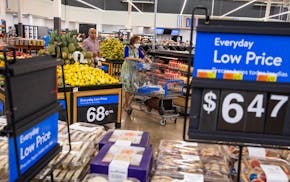Former President Donald Trump appears likely to be re-elected this fall.
Bond investors are betting that way, and last week's debate showed that President Joe Biden can no longer do the job. Democrats made a foolish decision by sticking with Biden, and polls show the rest of the country won't do the same in November.
What does this mean for the Minnesota economy?
At his rallies, Trump frequently says he will impose a 10% tariff on all imports to the U.S. and a 60% tariff on goods from China. He also plans to deport millions of illegal immigrants and impose his will on the Federal Reserve.
I doubt he'll succeed with the latter two things, though attempting them will slow the overall economy. He'll confuse financial markets trying to influence the Fed. He'll disrupt construction, agriculture and other industries that rely on immigrant workers.
His tariff policies will lead to more inflation in the U.S. and retaliation from other countries on American-made goods. Trump insisted at the debate that tariffs don't raise prices on consumers, but that's untrue.
I disliked Trump's trade policies in his first term. The trade war he started with China, and tariffs he imposed on other goods the U.S. imports, hurt Minnesota consumers.
When China retaliated, the state's farmers were harmed as exports of their crops fell. To make up for the damage, the government raised its payments to farmers, which were below $20 billion the first two years Trump was in office, to nearly $50 billion in 2020.
Though the first question Trump and Biden were asked at the debate was about the nation's economic future, they responded by arguing over what happened to the economy in the 2020, when the COVID-19 pandemic disrupted it.
Inconveniently for Minnesotans and for Trump and Biden, data released the morning after the debate showed that the Minnesota economy contracted 0.8% in the first three months of this year.
Eight of the 12 Midwest states experienced declines, with South Dakota and North Dakota hit hardest. Michigan and Missouri grew more than 1%, while Indiana and Wisconsin grew less than 1%.
There's a chance that in late September, when data is released for the April-through-June quarter, we will learn that Minnesota and most of the Midwest spent the first half of the year in recession. Minnesota's economy grew 0.7% in the second quarter of 2023, meaning that the comparative figure could be beaten.
If it's not and we wind up with two consecutive quarters of GDP decline to meet the official definition of recession, I won't be surprised.
The Federal Reserve from 2022 through last summer year raised interest rates sharply to tame inflation. In doing so, it also slowed economic growth, which often tends to increase joblessness.
Instead, the overall U.S. economy has responded to the higher-rate medicine much better than expected. Job growth has remained fairly strong and unemployment low.
And yet, the effects of a slowdown are visible. Look around and you'll notice how few construction cranes there are in the metro area. There are none in downtown Minneapolis for the first time in my memory. There's one up across the river near the University of Minnesota campus.
Since 2016, Trump campaigned on the notion that illegal immigrants steal jobs from Americans. It's something he has complained about since the 1980s even though he routinely employed them in his businesses, even while president.
However, labor markets in much of the country changed from loose to tight while he was in office and grew tighter still since 2020 as more baby boomers retired. Minnesota is one of about a dozen states that have a smaller workforce than they did in February 2020, the month before pandemic-related shutdowns.
And it's not like Minnesotans are sitting on the sideline. The state has one of the highest rates of labor force participation in the U.S. at 68%.
I have yet to hear Trump speak about the scarcity of labor, its effects on Minnesota or other parts of the nation.
Last month, Sen. J.D. Vance of Ohio, who aspires to be Trump's running mate, gave an interview with New York Times columnist Ross Douthat that made news chiefly because of the way Vance dismissed Trump's influence on the Jan. 6 uprising at the U.S. Capitol.
Vance's comments on economics were almost as startling.
"I think the economics profession is fundamentally wrong about both immigration and about tariffs," Vance said. "Yes, tariffs can apply upward pricing pressure on various things — though I think it's massively overstated — but when you are forced to do more with your domestic labor force, you have all of these positive dynamic effects."
Instead of relying so much on immigrants to fill jobs, Vance argues U.S. employers need to re-attract the approximately 7 million working-age men who checked out of the labor force. Those men are out there, analysts Richard Reeves of the Brookings Institution and Nicholas Eberstadt of the American Enterprise Institute have documented in recent books.
I suspect the price to bring them back to work is higher than Vance thinks. And I doubt Trump has ever thought about it.

Ramstad: Readers say Walmart won't be paying the ultimate price of Trump's tariffs

Ramstad: Gov. Walz, things are not getting done in Minnesota

Ramstad: AI is English-centric, but it's picking up Hmong quickly

Ramstad: Minneapolis' Camden neighborhood is rising. Houston White wants to keep it that way.


